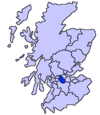History
The oldest documented reference to Cardowan comes from the Charters of David I of Scotland regarding the lands around Cardowan, Easter Cardowan, and Cardowan Muir. These areas of land currently include the Forestry Commission's Cardowan Moss and the village of Cardowan.
The oldest surviving buildings in the area are St. Joseph's RC Church, the original St. Joseph's School, Craigendmuir House, as well as older structures in adjacent Stepps. Excluding Cardowan Drive and the northern end of Cardowan Road which are often regarded as being part of Stepps, the earliest housing in the area which is still existing was built in the late 1930s to early 40s and served to replace housing in the (now extinct) nearby villages of Garnkirk and Heathfield.
The streets of Cardowan Road, Clayhouse Road, and Frankfield Road were constructed first, with the easternmost end of the latter being renamed Ardtoe Crescent and Place and Dorlin Road a short time later. Thereafter further housing was built in the 1950s creating the streets of Craigendmuir Road, Comedie Road and an extension to Clayhouse Road. Following this in the 1960s, Drimnin Road, and Mossview Road (including Resipol Road and Gaskin Path) were completed. Due to the shortages of building materials during the second World War the last five blocks on Frankfield Road were built with flat roofs which were only replaced in the 1980s. The 1980s also brought the construction of Blaneview and further housing on Clayhouse Road, and in the 1990s Nicholson Court was built on the site of the original Stepps railway station and sidings.
Cardowan Colliery
The mine at Cardowan was the site of several accidents including the explosion of 1927 in which on 1 August at 3:50pm 3 men were killed. (John Kilpatrick, Maurice M'Bride, George Jackson) A further explosion occurred in 1932 on 16 November in which 11 men were killed. (William Bradley, Michael Flynn, Peter Frati (formerly Jacobelli), William McAlister, John McNab, James McVey, Richard Maroney, George Mullen, James Reynolds, John Watt, John Whiteford) Then again in Jan 1982 there was another explosion at some 1700 feet underground and 2 miles from the pithead, resulting in 41 injuries. The mine finally closed at the end of 1983.

Lanarkshire, also called the County of Lanark, is a historic county, lieutenancy area and registration county in the Central Lowlands of Scotland. The county is no longer used for local government purposes, but gives its name to the two modern council areas of North Lanarkshire and South Lanarkshire.

The M80 is a motorway in Scotland's central belt, running between Glasgow and Stirling via Cumbernauld and Denny and linking the M8, M73 and M9 motorways. Following completion in 2011, the motorway is 25 miles (40 km) long. Despite being only a two lane motorway, parts of the M80 Stepps Bypass are used by around 60,000 vehicles per day.
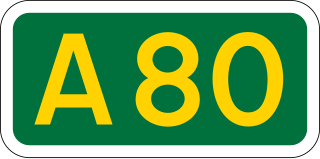
The A80 is a road in Scotland, running from the A8 to Moodiesburn, north east of Glasgow. Prior to the M80 opening, the A80 was one of Scotland's busiest trunk roads.
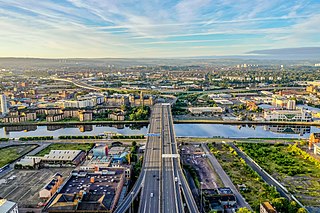
The city of Glasgow, Scotland has a transport system encompassing air, rail, road, and an underground light metro line. Prior to 1962, the city was also served by trams. Commuters travelling into Glasgow from the neighbouring local authorities of North and South Lanarkshire, Renfrewshire, East Renfrewshire, and East and West Dunbartonshire have a major influence on travel patterns, with tens of thousands of residents commuting into the city each day. The most popular mode of transport in the city is the car, used by two thirds of people for journeys around the city.

Robroyston is a suburb of Glasgow, Scotland, located around 3 miles (5 km) north-east of the city centre.

Hogganfield is a district in the Scottish city of Glasgow, located to the north east of the city centre. Hogganfield is surrounded by the Glasgow districts of Blackhill, Craigend, Millerston, Provanmill, Riddrie, Robroyston, Ruchazie and Stepps. The M80, Stepps bypass, separates Hogganfield from Robroyston.

Millerston is a district partially in the Scottish city of Glasgow and partially in North Lanarkshire. It is situated north of the River Clyde, to the north of the city's Craigend, Garthamlock and Ruchazie neighbourhoods, but physically separated from them by parkland and wooded areas. It is also home to the playing fields of Glasgow's St Aloysius College and Strathclyde University.
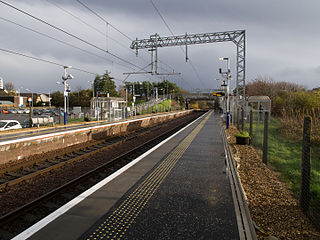
Stepps railway station serves the town of Stepps, North Lanarkshire, Scotland. The railway station is located on the Cumbernauld Line, 5¼ miles (8 km) north east of Glasgow Queen Street and is managed by ScotRail.

Auchinloch is a village in Scotland, situated within the North Lanarkshire local authority area but very close to the boundary with East Dunbartonshire and sharing the G66 postcode of the town of Kirkintilloch and the adjoining village of Lenzie, located a short distance to the north. Other nearby settlements in North Lanarkshire are Stepps to the south and Chryston to the south-east, each approximately 1.3 miles (2.1 km) away across farmland and on the opposite side of the M80 motorway; the Glasgow City council area boundary and the suburb of Robroyston is about the same distance to the west. In previous years Auchinloch was in the Parish of Cadder and, from 1975 until 1996, the district of Strathkelvin within Strathclyde Region.

Castlecary is a small historic village in North Lanarkshire, Scotland, directly adjacent to the border with Falkirk. It has long been associated with infrastructure, being adjacent to a bridged river, a Roman fort and roads, a nationwide canal, a Victorian railway viaduct, and a modern motorway. Castlecary is close to the town of Cumbernauld but like Dullatur and Luggiebank is not officially part of the town. Around 1725, the barony of Castlecary, with a population of just seventeen families, was disjoined from the parish of Falkirk, and annexed to Cumbernauld quoad sacra. Castlecary is also near Allandale which, though in the Falkirk council area, was built for Castlecary fireclay workers.
The Bruce Report is the name commonly given to the First Planning Report to the Highways and Planning Committee of the Corporation of the City of Glasgow published in March 1945. It influenced an intensive programme of regeneration and rebuilding efforts which took place in the city and surroundings from the mid-1950s and lasted until the late 1970s. The author was Robert Bruce, Glasgow Corporation Engineer at the time.
Stepps is a town in North Lanarkshire, Scotland, near the north-eastern outskirts of Glasgow. Its recently upgraded amenities include a new primary school, library and sports facilities. The town retains a historic heart around its church in Whitehill Avenue, whilst examples of Victorian and Edwardian housing can still be found. The travel connections by road and rail mean residents work in Glasgow, Edinburgh, Falkirk, Stirling and beyond. The town is located in close proximity to the new Seven Lochs Wetland Park, from which views to the Campsies and Loch Lomond can be enjoyed. Stepps has a population of around 6,730.
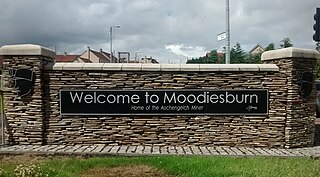
Moodiesburn is a village in Scotland, located 8 miles northeast of Glasgow, in the North Lanarkshire council area. It is situated on the north side of the A80 road and between the M73 and M80 motorways which converge nearby. Moodiesburn does not directly adjoin any other settlements, though the villages of Chryston and Muirhead are located a short distance to the west, with Stepps beyond, and outer parts of Cumbernauld lie to the east; however, the town centres are about 5 miles apart.

Gartcosh is a village in North Lanarkshire, Scotland. The village lies a few miles east of Glasgow, and about one mile northwest of the town of Coatbridge.
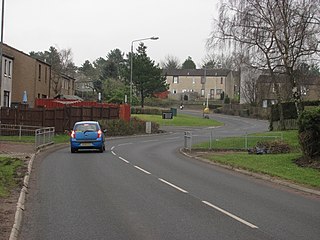
Westfield is an area of the town of Cumbernauld in Scotland. Westfield is a popular residential area originally built by Cumbernauld Development Corporation in the late 1970s and early 1980s. It comprises a residential area and a large industrial estate. Historically there was a farm at Westfield as shown on Roy's map of the Lowlands and the 1st 25 inch Ordnance Survey Map of Scotland. It is located near Condorrat and Broadwood Stadium, home of Clyde FC. Historically, there were two local primary schools, St Francis of Assisi Primary School and Westfield Primary School. St. Francis of Assisi Primary School closed in 2009. The site has been re-developed by North Lanarkshire Council with new, high quality social housing available to rent. The new street is named Netherinch Way. Westfield also has other modern, private developments for example a new Bellway Housing development sits near Broadwood stadium along with a neighboring housing development. Westfield has a selection of frequent bus services to Airdrie, Cumbernauld Town Centre, Glasgow, Kilsyth and Kirkintilloch with buses operated by David Allan Coaches, First Group & McGills. In 2017 plans for a new retail park near Broadwood Studium were approved.

Muirhead is a small town approximately 7 miles (11 km) north-east of Glasgow city centre. Nearby villages and towns include Chryston, Garnkirk, Gartcosh, Moodiesburn, Lenzie and Stepps. Muirhead has a population of around 1,390. It is a commuter town to Glasgow with road links with the A80/M80 and frequent bus services the 37c x35, x37, and x3. Muirhead is located approximately two miles from Gartcosh, Lenzie and Stepps railway stations.

Garnkirk is a settlement in North Lanarkshire, located a mile (1.5 km) southwest of Muirhead. It is located 10 km northeast of Glasgow's city centre and 23 km southwest of Falkirk. Garnkirk is connected via the nearby motorways M8, M73 and M80. This provides access to Cumbernauld, Glasgow and Stirling. The nearest modern railway stations are in Gartcosh and Stepps.

Cumbernauld is a large town in the historic county of Dunbartonshire and council area of North Lanarkshire, Scotland. It is the tenth most-populous locality in Scotland and the most populated town in North Lanarkshire, positioned in the centre of Scotland's Central Belt. Geographically, Cumbernauld sits between east and west, being on the Scottish watershed between the Forth and the Clyde; however, it is culturally more weighted towards Glasgow and the New Town's planners aimed to fill 80% of its houses from Scotland's largest city to reduce housing pressure there.

The Seven Lochs Wetland Park is an urban park in Scotland. It comprises nearly 20 km² of land and water between Glasgow and Coatbridge.

North East is one of the 23 wards of Glasgow City Council. On its creation in 2007 and in 2012 it returned four council members, using the single transferable vote system. For the 2017 Glasgow City Council election, the ward boundaries were redrawn with a smaller size and population, and it returned three members.




